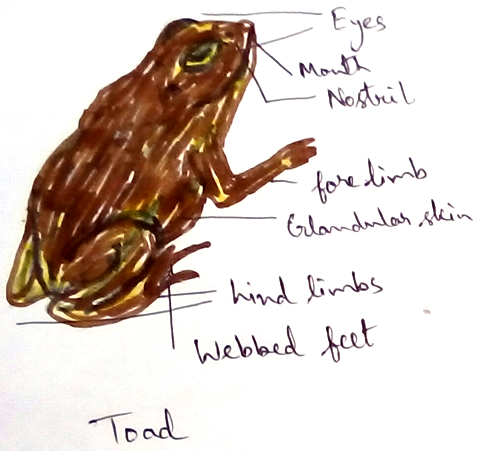Division of Subphylum
Vertebrata is the largest subphylum of chordata which is characterized by the formation of cranium and vertebral column instead of notochord and brain, spinal cord instead of dorsal nerve cord. It is also called craniata due to presence of cranium and euchordata as most of the characters of chordata are expressed in vertebrata.
Characteristics features of vertebrata are:
1. Dorsal nerve cord get differentiated into brain and spinal cord.
2. Notochord is replaced by vertebral column around the spinal cord and cranium around the brain.
3. Exoskeleton and endoskeleton is differentiable.
4. Gill slits occur at least in embryo stage.
5. Heart is ventral.
6. Blood contains haemoglobin in red blood cells.
7. Paired lateral appendages ,tail, endocrine glands, autonomous nervous system and portal system ( hepatic, renal, hypophyseal) are the other traits present in subphylum Vertebrata.
Division of Vertebrata - the subphylum Vertebrata can be divided into two groups . They are –
1. Agnatha – It is a group of poikilothermic animals. Vertebrates of this group donot contains paired appendages, girdles and jaws . Mouth is sectorial. External naris is single whereas internal naris is absent. It can be divided into two – Ostracodermi (a group of fossil Agnatha, osteostracs and heterostraciare included in this category. Another group is cyclostomata. Lamprey, Hagfish are example of cyclostomata.Agnathaconsist of class cyclostomata. Characteristics of cyclostomata are –
Mouth is circular, jawless, suctorial, horny teeth, skin is smooth , without scales and has mucous glands. Notochord and imperfect vertebrae occur. Gills are without sacrificing like pouches (marsipobronchi). Heart is two chambered,RBC s are irregular, digestive system is without stomach. External naris, olfactorysac,gonad, find are unpaired. Kidneys are mesonephros,gonoduct is absent.External fertilization is occurred larval stage (ammocoete) occurs. Example- lamprey, hagfish etc.
2. Gnathostomata – The animals of this group possesses jaws ,paired appendages, pared nares and an exoskeleton. It contains different classes. They are –
Fish/Pisces: Exclusively aquatic, appendages are fins for swimming, respiration through gills, body covered by dermal scales, cold blooded gnathostomata, heart two chambered. It is of two types – Chondrichthyes (skeleton made up of cartilage), ostecthys (bony fish). Example of pisces are Catla, rohu, hilsa etc). Example of condrichthyes are shark etc.
Amphibians: Their phases of life cycle are dependent on both land and water. They are three chambered heart, cold blooded animals. Limbs are first observedin amphibian (two pairs). Thus they are first tetrapods. Example of amphibians are frog, toad etc.
Reptiles: They are tetrapodswhich have incomplete four chamber heart. Bodies are covered by dry scale, maximum of them are terrestrial.
Example of reptiles are snake, lizard , crocodile etc.
Aves: They are the first warm blooded (their body temperature remain unchanged with the change of their temperature of surrounding)animals that appeared on the earth. They have four chambered heart where the fore limbs are converted into wings. Whole body is covered by feather.
Mammals: Mammals are the most advanced and intelligent animals on the earth.They are having, mammary gland, give direct birth to the baby.
From Division of Subphylum to HOME PAGE
Recent Articles
-
What Is Plasma? | Blood Plasma | Proteins | Nutrients | Cholesterol
Nov 07, 25 10:29 AM
Blood is a mobile fluid which is a connective tissue and is derived from the mesoderm like cell any other connective tissue. Colour of blood is reddish and that flows inside the blood vessels by means… -
Disorders of Respiratory System | Tuberculosis | Pleurisy | Emphysema
Oct 28, 25 11:39 PM
Tuberculosis is very common disease and is caused by a type of bacteria called Mycobacterium tuberculosis. This disease causes different trouble in the respiration and infection of several parts of th… -
Regulation of Respiration | Respiratory Centres | Inspiratory Area |
Oct 14, 25 12:13 AM
Respiratory Centre is the area that controls the rate of respiration and it is observed to be located in medulla oblongata and pons. Respiratory Centre has the following will dispersed components like… -
Explain Transport of Gases | External Respiration | Tissue Respiration
Oct 09, 25 11:35 PM
In humans gaseous exchange is completed in the following ways the steps are - External Respiration or Breathing - Breathing in false taking in of Oxygen and giving out of carbon dioxide in the body. M… -
Kind and Number of Teeth | Location of Teeth in Mouth | Care of Teeth
Sep 11, 25 12:52 AM
Kind and Number of Teeth








New! Comments
Have your say about what you just read! Leave me a comment in the box below.